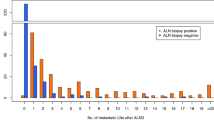Abstract
Background
American College of Surgeons Oncology Group (ACOSOG) Z0011 defined clinical node negativity by physical examination alone. Although axillary ultrasound with biopsy has a positive predictive value for lymph node (LN) metastases approaching 100 %, it may not appropriately identify clinically node-negative women with ≥3 positive LNs who require axillary lymph node dissection (ALND). We sought to identify the total number of positive LNs in women presenting with cT1–2N0 breast carcinoma with a positive preoperative LN biopsy to evaluate the potential for overtreatment when ALND is performed on the basis of a positive needle biopsy in patients who otherwise meet ACOSOG Z0011 eligibility criteria.
Methods
Patients with cT1–2N0 breast cancer by physical examination with a positive preoperative LN biopsy were identified from a prospective institutional database. Clinicopathologic characteristics and axillary imaging results were compared between women with 1 to 2 total positive LNs and ≥3 total positive LNs.
Results
Between May 2006 and December 2013, a total of 141 women with cT1–2N0 breast cancer had abnormal axillary imaging and a preoperative positive LN biopsy (median patient age 51 years, median tumor size 2.4 cm, 86 % ductal histology, 79 % estrogen receptor positive). Sixty-six women (47 %) had 1 to 2 total positive LNs, and 75 (53 %) had ≥3 total positive LNs. Women with ≥3 total positive LNs had larger tumors (2.4 vs. 2.2 cm, p = 0.03), fewer tumors with ductal histology (79 vs. 94 %, p = 0.01), more lymphovascular invasion (80 vs. 61 %, p = 0.01), and higher median body mass index (29.2 vs. 27.1 kg/m2, p = 0.04). Having >1 abnormal LN on axillary imaging was significantly associated with having ≥3 total positive LNs at final pathology (68 vs. 43 %, p = 0.003).
Conclusions
Axillary imaging with preoperative LN biopsy does not accurately discriminate low- versus high-volume nodal disease in clinically node-negative patients.

Similar content being viewed by others
References
Donker M, van Tienhoven G, Straver ME, et al. Radiotherapy or surgery of the axilla after a positive sentinel node in breast cancer (EORTC 10981-22023 AMAROS): a randomised, multicentre, open-label, phase 3 non-inferiority trial. Lancet Oncol. 2014;15:1303–10.
Galimberti V, Cole BF, Zurrida S, et al. Axillary dissection versus no axillary dissection in patients with sentinel-node micrometastases (IBCSG 23-01): a phase 3 randomised controlled trial. Lancet Oncol. 2013;14:297–305.
Giuliano AE, Hunt KK, Ballman KV, et al. Axillary dissection vs no axillary dissection in women with invasive breast cancer and sentinel node metastasis: a randomized clinical trial. JAMA. 2011;305:569–75.
Giuliano AE, McCall L, Beitsch P, et al. Locoregional recurrence after sentinel lymph node dissection with or without axillary dissection in patients with sentinel lymph node metastases: the American College of Surgeons Oncology Group Z0011 randomized trial. Ann Surg. 2010;252:426–32.
Sola M, Alberro JA, Fraile M, et al. Complete axillary lymph node dissection versus clinical follow-up in breast cancer patients with sentinel node micrometastasis: final results from the multicenter clinical trial AATRM 048/13/2000. Ann Surg Oncol. 2013;20:120–7.
Rao R, Euhus D, Mayo HG, et al. Axillary node interventions in breast cancer: a systematic review. JAMA. 2013;310:1385–94.
Shah-Khan M, Boughey JC. Evolution of axillary nodal staging in breast cancer: clinical implications of the ACOSOG Z0011 trial. Cancer Control. 2012;19:267–76.
Houssami N, Ciatto S, Turner RM, et al. Preoperative ultrasound-guided needle biopsy of axillary nodes in invasive breast cancer: meta-analysis of its accuracy and utility in staging the axilla. Ann Surg. 2011;254:243–51.
Fornage BD. Local and regional staging of invasive breast cancer with sonography: 25 years of practice at MD Anderson Cancer Center. Oncologist. 2014;19:5–15.
Diepstraten SC, Sever AR, Buckens CF, et al. Value of preoperative ultrasound-guided axillary lymph node biopsy for preventing completion axillary lymph node dissection in breast cancer: a systematic review and meta-analysis. Ann Surg Oncol. 2014;21:51–9.
Rattay T, Muttalib M, Khalifa E, et al. Clinical utility of routine pre-operative axillary ultrasound and fine needle aspiration cytology in patient selection for sentinel lymph node biopsy. Breast. 2012;21:210–4.
Houssami N, Diepstraten SC, Cody HS 3rd, et al. Clinical utility of ultrasound-needle biopsy for preoperative staging of the axilla in invasive breast cancer. Anticancer Res. 2014;34:1087–97.
Schipper RJ, van Roozendaal LM, de Vries B, et al. Axillary ultrasound for preoperative nodal staging in breast cancer patients: is it of added value? Breast. 2013;22:1108–13.
Caudle AS, Kuerer HM, Le-Petross HT, et al. Predicting the extent of nodal disease in early-stage breast cancer. Ann Surg Oncol. 2014;21:3440–7.
Verheuvel NC, van den Hoven I, Ooms HW, et al. The role of ultrasound-guided lymph node biopsy in axillary staging of invasive breast cancer in the post–ACOSOG Z0011 trial era. Ann Surg Oncol. 2014;22:409–5.
van Wely BJ, de Wilt JH, Francissen C, et al. Meta-analysis of ultrasound-guided biopsy of suspicious axillary lymph nodes in the selection of patients with extensive axillary tumour burden in breast cancer. Br J Surg. 2015;102:159–68.
Hieken TJ, Trull BC, Boughey JC, et al. Preoperative axillary imaging with percutaneous lymph node biopsy is valuable in the contemporary management of patients with breast cancer. Surgery. 2013;154:831–8.
Pilewskie M, Jochelson M, Gooch JC, et al. Is preoperative axillary imaging beneficial in identifying clinically node-negative patients requiring axillary lymph node dissection? J Am Coll Surg. 2015 (in press).
Disclosure
The authors declare no conflict of interest. This study was funded in part by NIH/NCI Cancer Center Support Grant No. P30 CA008748.
Author information
Authors and Affiliations
Corresponding author
Rights and permissions
About this article
Cite this article
Pilewskie, M., Mautner, S.K., Stempel, M. et al. Does a Positive Axillary Lymph Node Needle Biopsy Result Predict the Need for an Axillary Lymph Node Dissection in Clinically Node-Negative Breast Cancer Patients in the ACOSOG Z0011 Era?. Ann Surg Oncol 23, 1123–1128 (2016). https://doi.org/10.1245/s10434-015-4944-y
Received:
Published:
Issue Date:
DOI: https://doi.org/10.1245/s10434-015-4944-y




